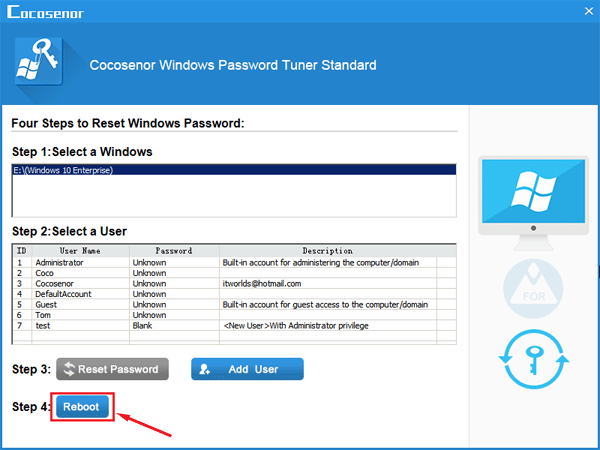
- HOW TO ADD A USER ACCOUNT ON WINDOWS 10 HOW TO
- HOW TO ADD A USER ACCOUNT ON WINDOWS 10 INSTALL
- HOW TO ADD A USER ACCOUNT ON WINDOWS 10 UPGRADE
- HOW TO ADD A USER ACCOUNT ON WINDOWS 10 WINDOWS 10
- HOW TO ADD A USER ACCOUNT ON WINDOWS 10 PASSWORD
HOW TO ADD A USER ACCOUNT ON WINDOWS 10 PASSWORD
Tip: The password hint is not a required field in this method, so you can skip the password hint box. Step 5: Enter a new password, reenter it, type password hint and click Create password. Step 2: Tap Change account type to move on. Way 3: Put password on user account in Control Panel. Tip: In this method, the password hint is a required field. Step 4: Type a new password, retype it, input password hint and click Next.
Step 3: Choose Sign-in options and tap the Add button under Password. Way 2: Set password for user account in PC settings.
HOW TO ADD A USER ACCOUNT ON WINDOWS 10 WINDOWS 10
Everyone should enter the password when they login Windows 10 using your account. In other words, your Windows 10 computer is protected with the password. Step 5: Enter a new password, reenter it and click OK.Īfter these five steps, a dialog shows up, prompting that the password has been set. Step 3: Right-click a user account and choose Set Password. Step 2: Open the Users folder in Local Users and Groups. Way 1: Create user password in Computer Management.
HOW TO ADD A USER ACCOUNT ON WINDOWS 10 HOW TO
How to Set Password for User Account in Windows 10
HOW TO ADD A USER ACCOUNT ON WINDOWS 10 INSTALL
The first time someone signs in using the account, Windows will create user folders and finish setting things up.īy default your local user account is set as a limited account, meaning it cannot install applications or make administrative changes to the machine.

Type a username, password, and password hint, and then click “Next.”Īfter clicking “Next”, you’re kicked back to the Accounts screen you saw earlier, but your new user account should now be listed. If you’ve created new accounts in Windows 7 and previous versions, the next screen will look familiar to you.

Again, ignore all this and click the “Add a user without a Microsoft account” link at the bottom. On the next page, Windows will suggest that you create an online account. Instead click the “I don’t have this person’s sign-in information” link at the bottom. Ignore the prompt to provide an email or phone number. Each one of these users can have their own Account so files and settings are. In the Microsoft Account window that pops up, you’ll be steered toward creating an online Microsoft account. Windows 10, like all Windows versions before it, has the ability to have more then one user, use the system. It’s a useful feature that allows you to monitor a child’s account, but not what we’re after here. You may be tempted by the “Add a family member” button, but that feature requires setting up an online Microsoft account and assigning members to your family. On the Accounts page, switch to the “Family & other people” tab, and then click the “Add someone else to this PC” button.

Press Windows+I to bring up the Settings app, and then click “Accounts.” Note that in Windows 10, that this is a separate beast from the “User Accounts” Control Panel entry. Create A New Local User Account In Windows 10įirst, you’ll need to access your user account settings. Let’s take a look at the process for creating new local user accounts in Windows 10. While you might be inclined to use the Microsoft account for the online features it provides, a standard local account-the kind you had in Windows 7 and previous versions-is great for people who don’t want to link their login to Microsoft and it’s a perfect fit for kids who don’t need all the extras (and might not even have an email address to link to the account in the first place). Creating separate local accounts for your kids or other users means that they can set things up the way they want, have separate user folders-Documents, Pictures, and so on-and ensure that those dubious Minecraft downloads they find on shady websites don’t infect your account. This is a not-so-secure practice and one most people should get out of the habit of.Ĭreating a secondary account for yourself (so you’re not always logged on with administrative privileges) is a great idea and one that significantly increases the security of your machine. Millions of Windows users never create secondary accounts on their machines and use their primary administrative account for everything.
HOW TO ADD A USER ACCOUNT ON WINDOWS 10 UPGRADE
When you upgrade Windows 10 your old account comes with you, when you do a clean install you make a new account during the process, but what about if you want to add additional local accounts? Read on as we show you how. How to Create a New Local User Account in Windows 10


 0 kommentar(er)
0 kommentar(er)
